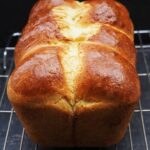
Light Brioche Loaf
Light Brioche Loaf is made with an easy, overnight dough enriched with butter, eggs, and milk. The result is a full flavoured loaf with a soft and fluffy crumb.
Unlike most brioche recipes, you don't need a stand mixer for this one and the kneading required is minimal. This means the texture won't be identical to classic brioche, but it's still a special loaf that's perfect for sandwiches, toasties, French toast, or slathered with butter and jam for breakfast.
Ingredients
- 500 g plain white flour plus extra for dusting
- 2 tsp instant dried yeast see Recipe Note #1
- 1.5 tsp salt
- 1 tsp sugar
- 80 g butter cut into small pieces (plus extra for greasing)
- 1 egg beaten
- 225 - 275 ml milk see Recipe Note #2
For the glaze
- 1 egg, beaten see Recipe Note #3
Instructions
The day before you want to bake the bread
-
In a large bowl, stir together the flour, yeast, salt, and sugar. Rub in the butter.
-
Make a well in the middle and tip in the beaten egg. Stir the mixture to start bringing it together, gradually adding enough of the milk to create a ragged ball of dough: the mixture will be quite stiff. Ensure there are no dry bits of flour visible.
-
Cover with cling film or a wet tea towel and leave overnight or 12-14 hours at room temperature.
Tip: the dough can be put in the fridge during hot weather or if you wish to leave it for longer (up to 24 hours).
On the day of baking
-
Grease a 900g / 2lb loaf tin with butter.
-
Lightly flour a clean work surface and scrape the dough onto it.
Knead the dough for 5 minutes or until smooth. If it sticks, dust the surface again with flour, using only the minimum to avoid a tough dough.
-
Using scales, divide the dough into 8 equal pieces then briefly knead each piece into a round ball.
Place the balls in the prepared tin in 2 rows of 4.
-
Put the tin in a large polythene bag or cover with cling film or a wet tea towel. Set aside somewhere warm for 45 minutes or until almost doubled in size.
Meanwhile, preheat the oven to 180°C / 160°C Fan / Gas 5 with a shelf in the middle and a deep roasting tray on the bottom shelf (this will be filled with cold water later to create steam and help the bread rise).
-
Check that the dough is proofed:
If, when a finger is gently poked into the dough, the dough slowly springs back but leaves a slight indentation then it is ready to bake.
If the dough springs back quickly then it's not yet fully proofed: leave it another 5 -10 minutes and check again.
-
When the dough is ready, add the glaze by brushing a layer of the beaten egg over the top of the loaf.
-
Place in the oven then carefully pour cold water from a jug into the hot roasting tray in the lower part of the oven. Immediately close the door.
Bake for 30 minutes.
-
After 30 minutes carefully open the oven door (caution: lots of hot steam may billow out so keep your face, hands etc. out of the way) and take the loaf out of its tin.
Place the loaf back in the oven directly on the shelf and cook for another 3 - 5 minutes or until the top of the loaf sounds hollow when tapped.
-
Transfer to a wire rack to cool.
Best eaten on the day it's made or can be frozen. Tip: slice before freezing so that you can take out what you need with no waste.
Recipe Notes
#1 Yeast. Dried yeast that needs activating before mixing with the other ingredients will NOT work with this method. Only use instant, fast-acting yeast that doesn't require activating first.
#2 Liquid. Different flours absorb different amounts of liquid so it's not possible to be exact about the amount you'll need to bring the dough together. See the image in the blog post as a guide to what the dough should look like.
#3 Egg for the glaze. You won't need a whole egg for the glaze so, if you don't have a use for the rest and don't want to waste it, you could hold back a tablespoon of the beaten egg from the dough and use that instead.